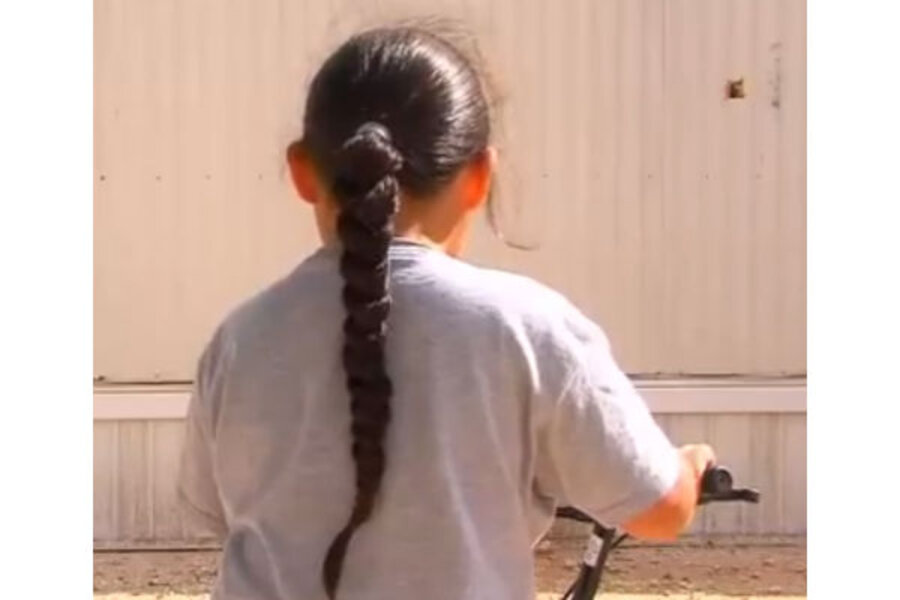Dress code flare up: Native American kindergartner sent home for braid
Loading...
On his first day of school, a 5-year-old Native American boy in Texas became the center of a firestorm over the length of his hair after an educator at F.J. Young Elementary School allegedly told the boy’s mother that his traditional long hair was a dress code violation.
What happened next in the life of Malachi Wilson is up for debate. His mother, April Wilson, told CBS affiliate Channel 7 in Seminole, Texas that she and her son were turned away on his first day of kindergarten and told that unless they could document his heritage, he would not be allowed to attend until his hair was cut.
According to the broadcast report, the boy was readmitted at the end of the same school day with an exception for his hair after his mother produced a certificate of authentication showing he is more than 50 percent Native American.
However, Seminole County Schools Superintendent Doug Harriman explained in a phone interview, “We don’t feel we sent the child home. We feel the mother chose to take him home after something may have been said to her by someone at the school. I can tell you that the child was in school all last week with all his hair on. No haircut.”
Malachi has a long braid of black hair, which tribal religious code dictate must not be cut except in time of mourning, according to Native American Netroots, an online forum for the discussion of political, social, and economic issues affecting the indigenous peoples of the United States.
The Seminole Independent School District is a public school system with 2,800 students, only four of whom have self-identified as Native American, according to Mr. Harriman.
This public school has the added – possibly ironic – distinction of being located in Seminole, Texas and having a Native American man in tribal dress as the school’s logo. The boys’ sport teams are “The Indians” and the girls are “The Maidens.” They play in WigWam Stadium according to the school’s website.
According to the school dress code on the school’s website, “Hairstyles or designs that are disruptive or distractive to the school environment are prohibited (i.e. Mohawks, rattails, dreadlocks, patterns or shavings in the hair, or spikes).”
“A dress code is the first step to discipline,” Mr. Harriman said during a phone interview. “Do we have a dress code? You betcha! Do we make exceptions for religious reasons? You betcha! Do we have here a conservative community that insists on a dress code in place? Well, yes, indeed, we sure do and it’s likely to remain that way.”
As the mother of four boys, each having gone through a long-hair phase, I’d like to state that hair in my household is sacred in many ways that are not Native American or even religious.
At my house hair has always been “sacred” in to my sons and me because it is part of our personal expressions of individuality.
I think there is a tradition here than can be altered – that of educators fixating on the appearance of students and trying to enforce conformity for the sake of order. It appears to cross both cultural and religious boundaries.
Many educators may be familiar with the classic literary tale of “Jane Eyre” wherein the head master of Lowood School berates a student named Julia for what he believes is the vanity of curling her hair in order to lure boys. In fact Julia’s hair is naturally curly. When Jane defends her friend, both girls have their hair cut off as part of a punishment by "mortification."
April Wilson clearly let it be known last week that she had raised her child in a tradition wherein hair was part of a “sacred” tradition. Instead of name-calling, as some parents might be tempted to do, Wilson referred to her religion and her sadness for he child.
“It’s kind of heartbreaking because how do you explain to a 5-year-old that he’s being turned away because of what he believes in? Because of his religion—because of what’s part of him,” his mother, Ms. Wilson told the local CBS affiliate. She added “Our hair is sacred to us.”
The thing I mourn is the fact that kids of varying religious and cultural beliefs are losing classroom time over what they look like.
In this case, I agree with Malachi’s mother, it’s heartbreaking to have to try and explain how and why adult educators would choose to focus on what could be considered by many a culture-blind approach to keeping order in a school environment.
In this case, a little boy just learned that life and educators can be less focused on a child’s personal beliefs as well as fundamentally unfair, because of a stringent dress code. Similarly, a mother learned how to comfort her child when situations happen that are out of his control.
Many lessons should come from this incident and the school’s approach to order, discipline, and the initial lack of flexibility on the part of the administration.
Perhaps sometime soon parents and educators will stop splitting hairs over student appearance and get right down to the business of what get's into their heads, instead of what’s on top of them.






